While my main interest is photographing people, a nuttier passion I have is photographing fireworks. It started out as just another photographic challenge but these days it’s turned into a slightly strange obsession of mine.
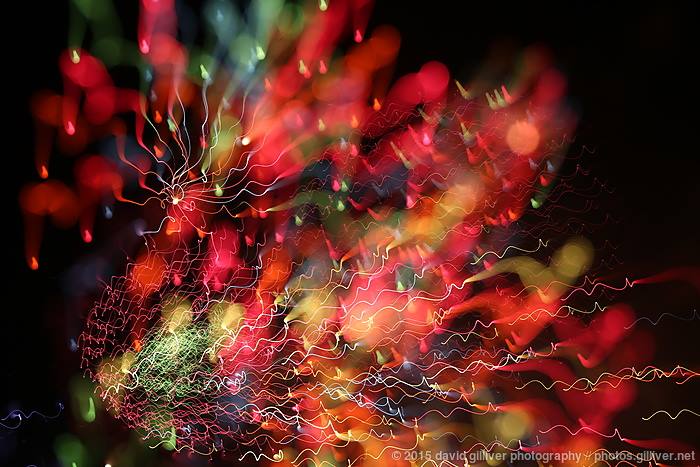
Generally speaking, if you know how to use a camera then fireworks photography isn’t particularly difficult to do. You don’t need an expensive camera or lens. You just need a basic understanding of the settings, which are usually something like this:
- ISO 100
- aperture: f/8 – f/16
- shutter speed: bulb
The main trick is using the bulb mode to open the shutter and then close it after capturing one or more explosions. You use the aperture to control the brightness and you use the shutter speed to determine how many explosions you capture. If the exploding shells are coming out white rather than coloured, you’re letting in too much light and you need to close down your aperture to stop the over-exposure. If you want to capture more explosions, keep the shutter open for longer but don’t open it for too long or you’ll get overexposure as the explosions get piled on top of each other.
Of course, you shoot fireworks on a tripod because you’re typically shooting with shutter speeds that exceed 1 second. You would normally connect a remote cable release to the camera so that you can minimise any camera shake as you press the shutter button. You can usually find cable releases cheap on ebay (usually less than <$10).
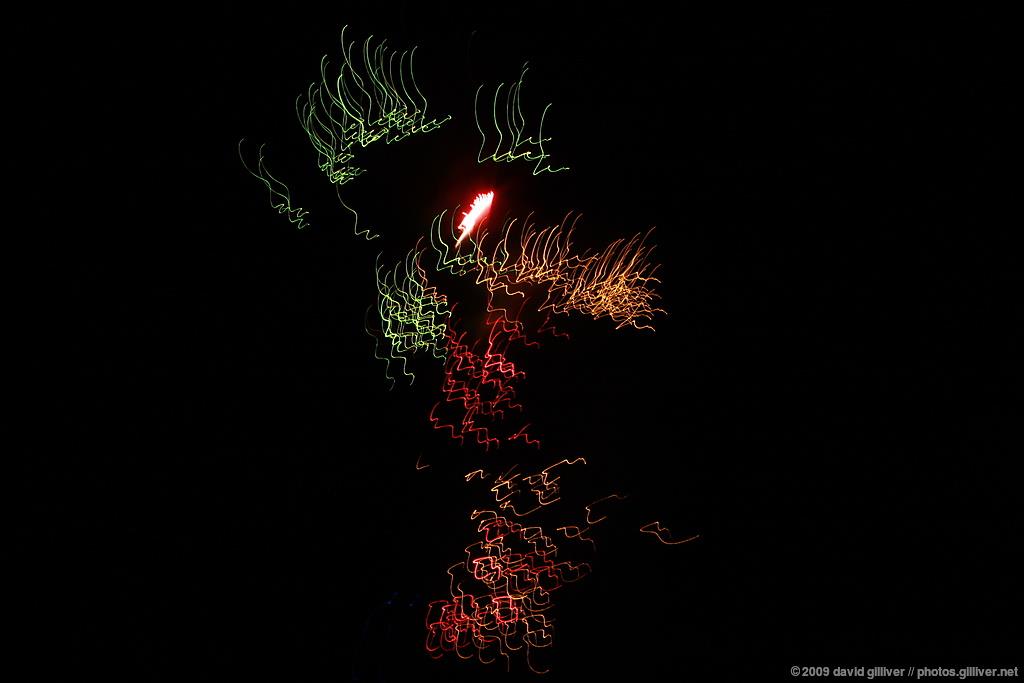
However, as you’ve probably noticed, my fireworks photos don’t look like traditional fireworks photos.
My experiments with fireworks photography started at the Melbourne Moomba Festival in 2009. I was with a friend having fun photographing a James Reyne performance just before the fireworks were due. Normally we would make sure we left the main stage about 15 minutes before fireworks launch time, giving us time to find a good spot and setup our tripods. On this occasion, we were enjoying the music a little too much and we threw that rather sensible plan out the window by staying until the end.
This meant that we only had a couple of minutes to rush off to setup for the fireworks. We didn’t have time to get out our tripods so we both sat down and attempted to hand-hold our cameras with as little movement as possible. As I was doing this (with only marginal success) it occurred to me: rather than fighting the unintended movement, what would happen if I added movement deliberately? Could breaking the conventional rule produce something interesting?
On that first occasion, I shook the camera, jerked it and waved it about in a figure 8 pattern. Most of the images were pretty crappy but a couple of them were strangely quirky. This weird technique was producing some unique photos.
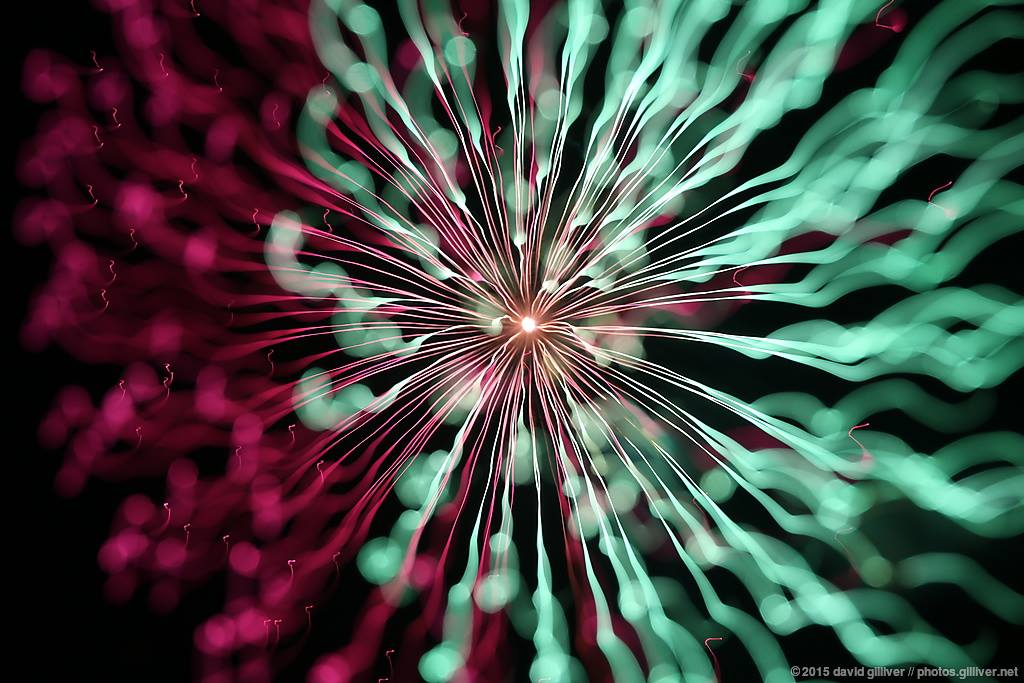
At subsequent fireworks events, I decided to try taking it further. I tried playing with the zoom dial during the exposure to give me light patterns streaking out from the centre. It then occurred to me that I could also play with the focus dial, starting the image in focus and turning it out of focus as the fireworks shell exploded. I later tried holding the focus ring steady while turning the camera, effectively changing the focus while creating a spiral effect.
My lens choice for shooting fireworks had now changed: whereas previously I’d shot with wide (eg. 17mm or 24mm) lenses to capture the whole fireworks scene, now I was shooting with a telephoto lens around 100mm. I was deliberately placing myself as close to the fireworks as practical so that I could shoot up and ensure I didn’t get any background objects (buildings, etc) in the shot. The goal was to keep things abstract and weird.
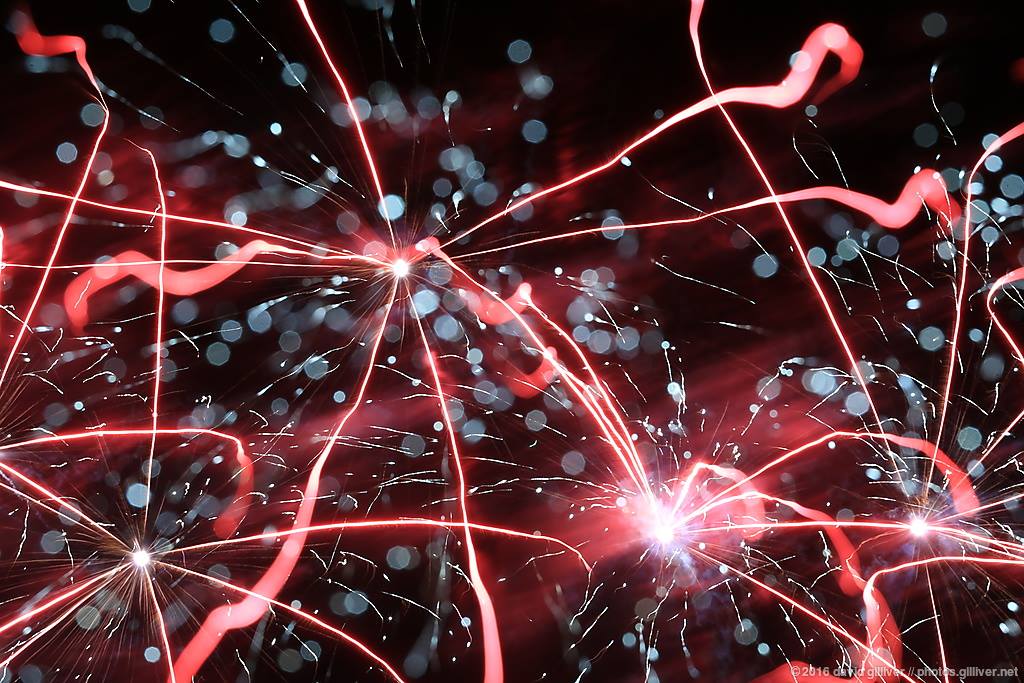
In a group of photographers at a fireworks event, I would stand out from the crowd: I wouldn’t have a tripod, I’d be shooting with a lens normally used for portraits and during the display, I’d be turning and bobbing about and wrestling with the camera. My technique was strangely physical in a way most photography isn’t. Photographers are usually aiming to keep the camera as steady as possible whereas I was working hard for the opposite. Occasionally friends would amuse themselves by filming me with their smartphone video cameras during a display.
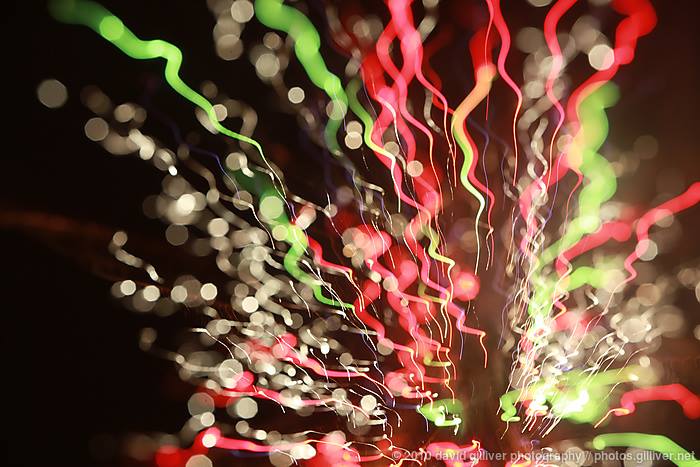
With some basic screw-it-up techniques figured out, I started looking for new ideas I could incorporate to create a wider variety of abstract photos. At some point I stumbled across some bizarre fireworks photos taken by Canadian photographer David Johnson. He was starting shots out of focus and he’d then pull the shot into focus as the shell exploded. With his camera fixed on tripod, this approach resulted in images resembling flowers with clean geometric shapes. Whereas I was closely tracking shells as they launched, he was shooting with a wider lens. In an explanation of his technique, he mentioned he was using a ND filter so that he could choose wider apertures, resulting in larger out-of-focus “blobs”.
From this I took the ND filter idea and I started putting my camera back on a tripod. However, I decided I wouldn’t keep the camera fixed like he did. Using a basic Manfrotto tripod head with 3 independent direction adjustments I would lock down one axis while leaving the other two free to move. This allowed me to keep tracking shells as they launched but it helped keep the camera steady during the exposure of the explosion. On some occasions when a series of shells launched to a consistent height, I would lock down the camera completely to eliminate any wobbling.
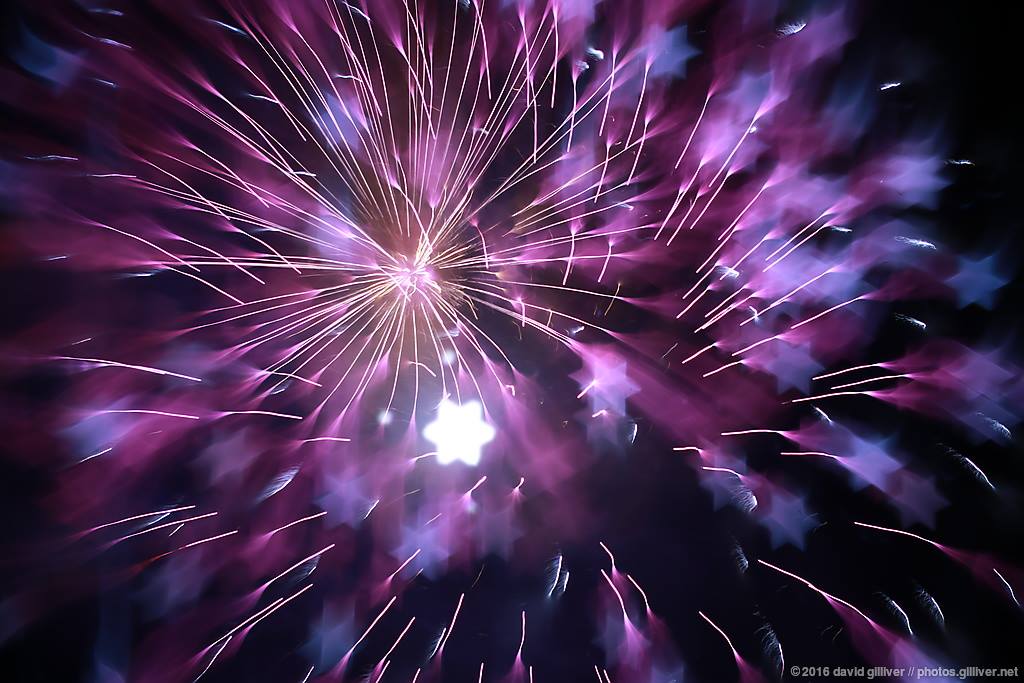
Recently I’ve started playing with adding a shaped bokeh kit to the front of the lens. This has little affect when the shot is in focus but out-of-focus parts of the image take on the shape of the kit cutout. I was now able to incorporate star shapes in my weird photos.
My current technique involves using a 85mm lens with a ND8 filter (3 stops) mounted on a semi-fixed tripod. I have one hand pressing the shutter button and moving the camera while my other hand is playing with the lens focus ring. There’s no need for a remote cable release.
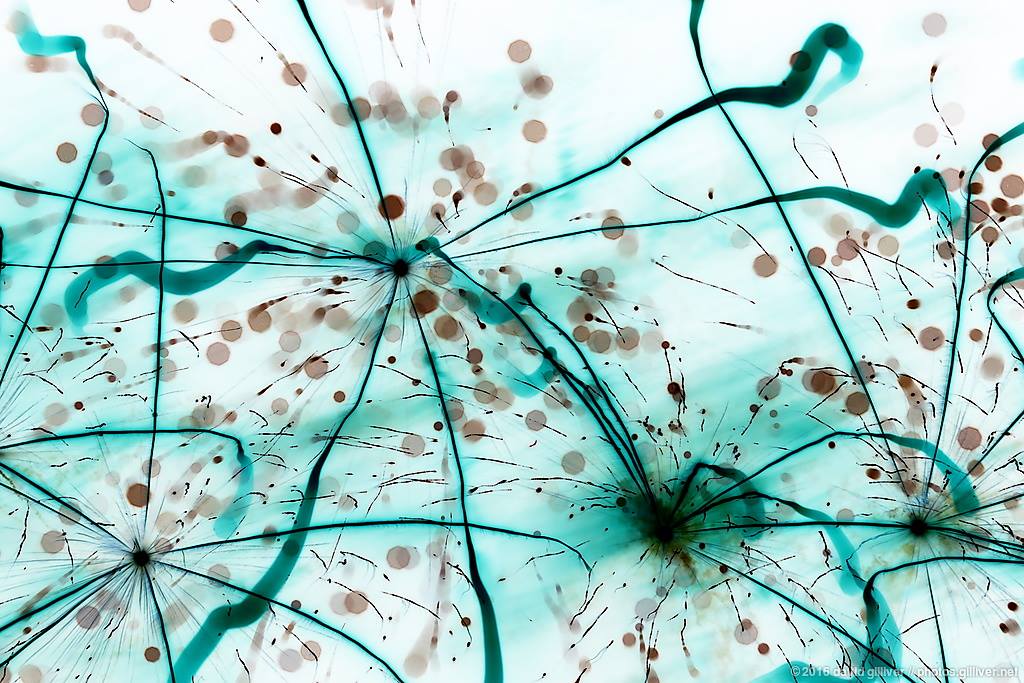
Fireworks consist of a standard set of chemicals for different colours so I frequently try different white balance settings to expand the colour palette. It’s also fun to try flipping the colours in post to generate “negative” images on white backgrounds.
The number of “keepers” from shooting a display can vary wildly: I get best results with less frantic displays that give me time to track individual shells. My success rate can vary between 0-20% of the shots taken (yes, sometimes it’s a waste of time). I don’t usually edit the images in any way as I love the challenge of getting it right in camera. This generally means no cropping, no colour tweaking and no-retouching. When I’ve shot at smaller apertures I have occasionally had images showing sensor dust spots so I’ve been forced to edit those slightly.
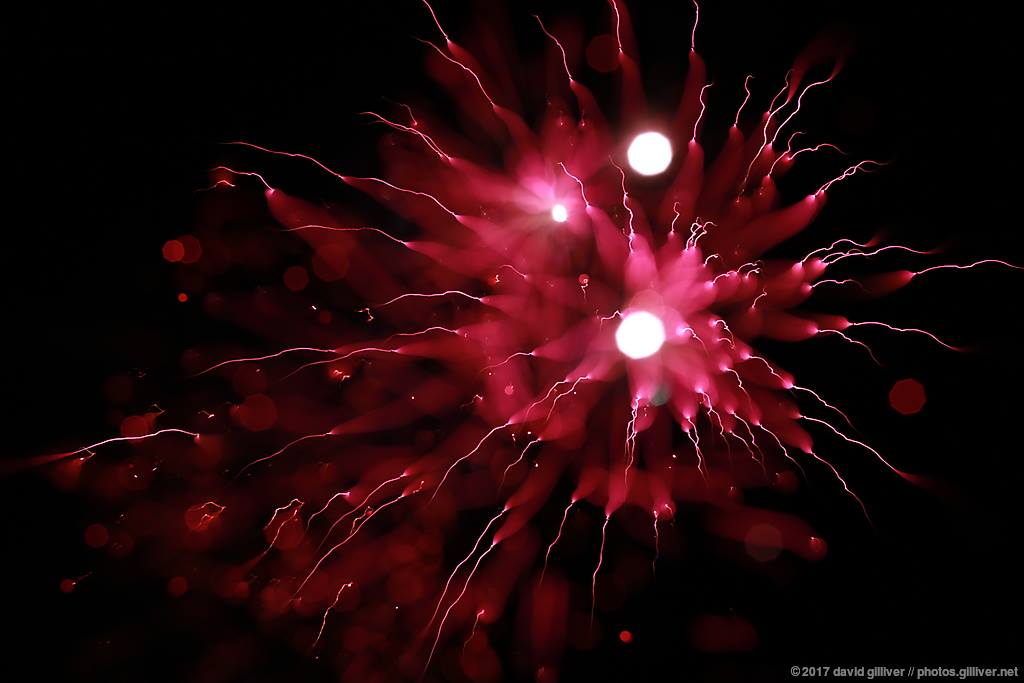
You could say I’ve given away all of the “secrets” of my technique here. However, the most important bit has nothing to do with photography: you need a fireworks display to shoot. In a way, this is the hardest bit as you have to hunt down events that will feature a fireworks display. I created a Facebook page “fireworks in Melbourne” in an effort to track these and hoped that others would offer tips of their local fireworks events. This page has been reasonably successful but the bulk of the listings are still discovered by me, using a combination of google searching and my own knowledge of recurring events that feature fireworks.
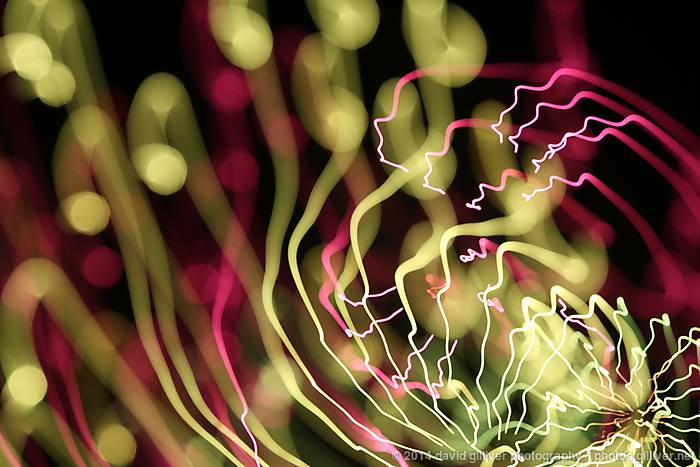
Of course, knowing about a display isn’t enough – you’ve then got to be able to get there. There are rare occasions when an event is close to home but it’s not unusual for me to drive an hour across town for what might turn out to be a 3 minute display. The most extreme travel has involved driving 650km north (and back) for the annual Gunning Fireworks Festival the last 2 years. You can’t assemble a portfolio of fireworks photos like mine without that kind of crazy commitment to the cause. Just because anyone can do it doesn’t mean they will.
Photography can be an addictive pastime: every time you get a good shot, you just want to rush out and do it again. I suspect I will get bored of shooting fireworks at some point but for now I’ll keep trekking across town in the hope of getting some new and interesting weird photos to add to my collection.
You can find my current set of “best” fireworks photos on my website. In late 2015 I created a print-on-demand Blurb book featuring many of them. You can buy prints and various products featuring the images on Redbubble. I also publish my images on flickr and Instagram.
If you’ve found the above rant useful, you may like to sign up to one of my regular photography workshops that I run in the Melbourne CBD. These occasionally include free fireworks photography workshops. All of my workshops are scheduled through my meetup.com group Melbourne Photography Education.
